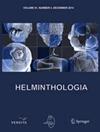Gastrointestinal parasites in captive wild birds in Mineiros, Goiás, Brazil
IF 1.2
4区 生物学
Q4 PARASITOLOGY
引用次数: 0
Abstract
Summary Studying parasites in captive wild birds is vital for their health, well-being, biodiversity preservation, species conservation, and safeguarding of both individual birds and ecosystems. It holds significance for public health by identifying potential zoonotic risks. We aimed to describe the occurrence of gastrointestinal parasites in captive wild birds from a Conservation Institute in Brazilian Cerrado biome. Fresh fecal samples were collected from 17 captive wild birds (巴西戈亚斯州米内罗斯圈养野鸟的胃肠道寄生虫
摘要 研究人工饲养野生鸟类体内的寄生虫对其健康、福祉、生物多样性保护、物种保护以及保护鸟类个体和生态系统都至关重要。通过识别潜在的人畜共患病风险,它对公共卫生也具有重要意义。我们的目的是描述巴西塞拉多生物群落保护研究所圈养野生鸟类胃肠道寄生虫的发生情况。我们在戈亚斯州米内罗斯的一个自然保护研究所收集了 17 只人工饲养野生鸟类(Anodorhynchus hyacinthinus、Ara ararauna、Ara chloropterus、Ara macao、Megascops choliba、Pteroglossus castanotis、Ramphastos dicolorus、Ramphastos tucanus 和 Strix huhula)的新鲜粪便样本。对样本进行了威利斯简单浮选和霍夫曼自发沉淀检查,以确定胃肠道内寄生虫的寄生形式。金刚鹦鹉(Ar. ararauna、Ar. chloropterus和Ar. macao)的阳性率较高,六份粪便样本中的蠕虫或原生动物均呈阳性。相比之下,人工饲养的巨嘴鸟只有两例阳性结果(P. castanotis 和 R. dicolorus)。蟒蛇身上有蛔虫卵、蛛形纲虫卵和吸虫卵;S. huhula身上有蛔虫卵。定期进行寄生虫学检查对于及时发现和治疗人工饲养鸟类的胃肠道感染至关重要,从而提高鸟类的整体管理水平。
本文章由计算机程序翻译,如有差异,请以英文原文为准。
求助全文
约1分钟内获得全文
求助全文
来源期刊

Helminthologia
生物-动物学
CiteScore
1.80
自引率
0.00%
发文量
21
审稿时长
>12 weeks
期刊介绍:
Helminthologia (HELMIN), published continuously since 1959, is the only journal in Europe that encompasses the individual and collaborative efforts of scientists working on a different topics of human, veterinary and plant helminthology. The journal responsibility is to enrich the theoretical and practical knowledge in very specific areas and thus contribute to the advancements in human and veterinary medicine and agronomy. Taking the advantage of comprehensive and multidisciplinary approaches journal still maintains its original spirit and is principal source of fresh scientific information regarding helminths, endoparasites and plant parasites. Addressing the most up-to date topics journal gained rightful and exceptional place next to the other high-quality scientific journals publishing in its field.
 求助内容:
求助内容: 应助结果提醒方式:
应助结果提醒方式:


